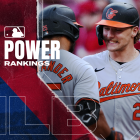
In recent years, you've probably heard the term "service-time manipulation" bandied about in baseball circles. Perhaps you are uncertain about what exactly service-time manipulation is. As with all matters of import, we are here for those with nowhere left to turn. That is, let's take a few revolutions of the second hand to explain what service-time manipulation in MLB is and why it matters.
In keeping with the injunctions of ancient sacred texts we shall do this in FAQ format with assistance from an imaginary interlocutor with an abiding interest in tedious business practices. Forthwith!
First of all, what's service time?
In MLB, "service time" is the term for how much time a player has spent in the majors, either as a member of the active roster or on the injured list. It's measured in days.
A typical MLB regular season -- it's worth emphasizing the word "typical" in light of the ongoing COVID-19 pandemic -- spans 187 days, and players must be on the 26-man roster or injured list for at least 172 of those days in order to accrue a full year of service time (or 172 across multiple seasons). Stated another way, players can be off the active roster/IL for up to 15 days during a season and still earn a year of service time. Also, players can't earn more than 172 days of service time in a season even if they exceed that number of days on the roster or IL.
Service time matters because it's in essence the "clock" for players when it comes to earning higher salaries via arbitration eligibility and free agency. Players are eligible for free agency after six full years of service time. A player with five years and 171 days of service time? His free agency gets delayed by a full year because he didn't satisfy the 172-day cutoff in that sixth year.
As for arbitration, players with between three and six years of service time* have their salaries determined or at least informed by that salary arbitration process. Regardless of whether player and team resolve their dispute in an arbitration hearing or settle before a hearing takes place, players enjoy significantly higher salaries during these years (albeit still well shy of their true market value).
So what's that * above about? That's to acknowledge that certain players known as "super-twos" are eligible for arbitration following their second full year of service time and thus can go through arbitration four times instead of three.
That point of all this is that accruing service time in essence means a player is getting closer to making life-changing money, assuming his skills are desired by the time he reaches those high-salary years.
And what is service-time manipulation?
It's when teams contrive reasons to leave a prospect in the minors even though said prospect is plainly ready for duty at the highest level. Often, they leave the prospect down just long enough to ensure he won't earn a full year of MLB service time during his rookie season. Less common but still somewhat prevalent is when teams hold down top prospects until after the super two deadline, which is a bit of a moving target from year to year. Doing so ensures they won't go through arbitration four times instead of three.
Why do teams do this?
The incentives are plain to see. By keeping a prospect in the minors for the first 16 days of what will be his rookie season, they can delay arbitration eligibility and free agency by a full year. In the former instance, it keeps costs down for the team. With the latter, they gain almost a full year of additional control over the player before he hits free agency.
Insofar as arbitration is concerned, teams are obligated to pay pre-arbitration players no more than the league minimum. Given that young players, thanks in part to advances in training and the general dedication to year-round skills development among serious baseball players, often arrive in the majors ready to realize their ceilings in short order, teams reap a great deal of surplus value from those players during the pre-arb years.
In the arb-eligible years, salaries increase significantly because players can have their salaries set by a panel of arbitrators. The player submits one salary figure for the season to come, and the team submits another. The arbitration panel picks one or the other, no splitting the difference or coming up with some other figure. Obviously, the player and team side are both well served by submitting realistic figures. Propose something outrageous and the panel will pick the other side's figure. Precedent also drives the panel's decision-making based on previous salaries for arbitration salaries, depending on whether the player is going through the process for the first, second, or third (or fourth) time. Both sides also argue for why their figure is the correct one, which carries with it the unintended consequence of having the team impugn the accomplishments of its own player. Since neither player nor team is particularly interested in getting to that point, most arb-eligible players and their teams settle on a figure long before it reaches a hearing. Whatever the case, the arb years for a player mean a drastic increase over the minimum salary.
If you're a team delaying that process by a full year in exchange for basically two weeks, it's an easy call. The same goes for pushing back free agency by an entire year by just barely preventing the player from getting a full year of service time in that first season.
So what's the problem?
At best, it's a cynical violation of a first principle of competitive sports -- that the best player plays. It's also, in essence, the billionaire class -- i.e. team owners -- behaving unethically to the detriment of their most underpaid employees.
One common quasi-defense of the practice goes a little something like this: The Players Association should've foreseen such behavior and negotiated penalties for it. Maybe there's something to that, but it's also difficult to prove service-time manipulation even when it's obvious it's happening. That said, it's possible there's a structurally based argument against the practice already.
Even if you're OK with the owners doing it because it may not be expressly forbidden by the collective bargaining agreement (CBA), there's no disputing that undermines the competitive integrity of the sport and puts the lie to the idea that personnel decisions in MLB are necessarily merit-based.
Are there any prominent examples of service-time manipulation that you'd like to hurriedly Google so as to pretend you knew them off the top of your head?
The classic recent case is that of Kris Bryant. The Cubs held Bryant down to start the 2015 season despite the fact that he was a 23-year-old college-trained hitter who had done nothing but punish pitchers in the high minors. Instead, the Cubs gave the Opening Day third base to Mike Olt and returned Bryant to Triple-A, supposedly to work on his defense. Well, Bryant was magically deemed ready after just seven games back on the farm. As a result, Bryant enters the 2021 season with five years and 171 days of MLB service time -- one shy of what he'd have needed to be a free agent this past offseason.
As well, back in 2014 George Springer prior to his major-league debut turned down a seven-year, $23 million contract offer from the Astros that quite presumably would've landed him on the active roster to start the season. After he rejected the offer, however, Springer was dispatched to the minors where he tidily spent the first 14 games of the season. Service-time manipulation and a reprisal for not bowing to the wishes of the front office? That counts as sweeping a doubleheader for the Jeff Luhnow-era Astros.
Proving that teams are operating with malice aforethought in such situations is difficult, as Bryant learned when he lost his grievance against the Cubs. That said, horse-sense suggests that many other prominent players were subjected to service-time manipulation -- Ronald Acuna Jr, Vladimir Guerrero Jr., Bryce Harper, and Evan Longoria likely among them.
Why are we talking about this now?
Nothing loosens lips quite like the captive embrace of the Greater Seattle rotarian. That's a lesson recently learned by disgraced former Mariners president Kevin Mather, who resigned after making several wrongheaded comments to an area rotary club in February. Among those comments was what's tantamount to an admission that the Mariners manipulated service time during the 2020 season and may intend to again in 2021. Thanks to the Mariners' apparent misdeeds and Mather's civic breakfast-powered candor, we're all aware that service time is still very much an issue in MLB.
What's the solution?
Whatever the solution is, it's not easily arrived at. It's likely that when the next CBA is negotiated in earnest this coming offseason, the issue of service-time manipulation will be addressed. The players will want some framework that drums it out of the game altogether, and the owners will want some kind of give-back for agreeing to do so. Timeless refrain, that one.
In the meantime, may all your manipulations feel like massages.






















